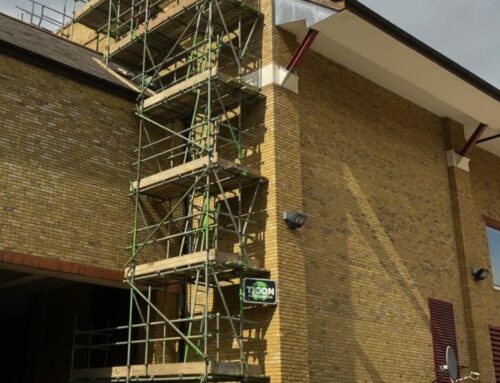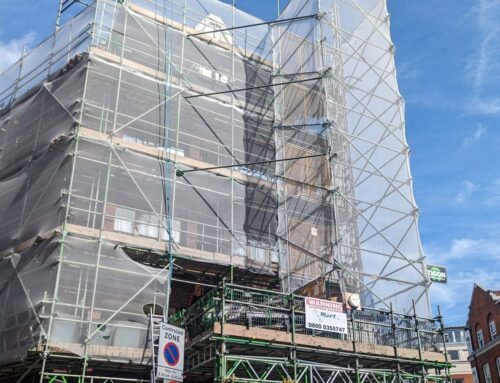Innovations in scaffolding equipment have long been at the forefront of revolutionising the construction industry, reshaping the way structures are built and fundamentally altering the landscape of modern architecture. Scaffolding, once a rudimentary necessity crafted from basic materials like wood and rope, has evolved into a sophisticated array of systems engineered for efficiency, safety, and adaptability. The importance of these innovations cannot be overstated, as they have not only facilitated the construction of monumental structures but also revolutionised the very process by which buildings are created. Today, advancements in scaffolding equipment permeate every aspect of the construction industry, from the materials used to the design principles employed, fundamentally transforming the way projects are planned, executed, and completed. As we delve into the intricacies of these innovations, we uncover a narrative of progress, ingenuity, and relentless pursuit of excellence that continues to shape the built environment in profound ways.
Pioneering the Heights: Ancient Scaffolding Innovations
Scaffolding’s rich heritage dates back to ancient civilisations like the Egyptians and Romans, where rudimentary structures enabled monumental construction endeavors. Innovations in scaffolding equipment during this era were revolutionary, heralding a new era of construction methodology. Through simple yet effective systems, ancient builders crafted scaffolds that defied gravity, enabling the realisation of monumental visions. Ropes, pulleys, and wooden platforms provided essential access for workers, shaping the landscapes that would define future ages. These early scaffolding methods laid the cornerstone for future advancements in construction access, leaving an indelible mark on the trajectory of architectural progress. Here are a few examples of their pioneering techniques:
Pyramids of Egypt: Ancient Egyptian builders constructed monumental pyramids using sophisticated scaffolding techniques. They employed ramps made from mud bricks or limestone to transport massive stone blocks to the construction site. As the pyramid grew in height, the ramps were extended and modified to accommodate the increasing size and weight of the stones. Wooden scaffolds, consisting of platforms supported by timber frames, were erected around the pyramid’s exterior to provide access for workers to carve and position the stone blocks with precision.
Roman Aqueducts: The Romans were renowned for their advanced engineering skills, particularly in the construction of aqueducts to transport water across vast distances. Scaffolding played a crucial role in the construction of these monumental structures. Roman scaffolders utilised wooden frameworks to support the arches and vaults of the aqueducts during construction. These scaffolds allowed workers to access the higher portions of the structure and lay the masonry with precision. Additionally, temporary wooden bridges were built across the top of the aqueducts to facilitate the transportation of materials and the movement of workers.
Roman Colosseum: The construction of the Roman Colosseum, one of the most iconic ancient structures, required innovations in scaffolding techniques. Roman builders utilised a combination of wooden scaffolds and earth ramps to construct the massive amphitheater. Wooden platforms were erected at various levels to provide access for workers to lay the stone blocks and install the seating tiers. The scaffolds were designed to be flexible and adjustable, allowing for the construction of the Colosseum’s elliptical shape and complex architectural features.
These examples illustrate the ingenuity and resourcefulness of ancient scaffolders, who played a vital role in the construction of some of the most impressive architectural achievements of antiquity. Through their innovations in scaffolding equipment, techniques, and meticulous craftsmanship, ancient scaffolders laid the foundation for future advancements in construction access and engineering.
Raising the Skyline: Medieval Scaffolding Innovations
During the medieval era in Europe, remarkable progress in scaffolding techniques reshaped the landscape of construction, ushering in an era of architectural magnificence that still captivates the imagination today. The erection of cathedrals, castles, and other grand structures stood as tangible expressions of human creativity and devotion. Innovations in scaffolding equipment flourished during this period, spurred by the demands of ambitious architectural projects and the ingenuity of craftsmen determined to conquer new heights. The advent of timber frame scaffolds marked a watershed moment in construction history, introducing structures characterised by interlocking wooden components that facilitated assembly and disassembly with remarkable ease. These innovative scaffolds were not merely tools of the trade; they were gateways to the sky, empowering craftsmen to ascend to unprecedented heights with confidence and safety. Moreover, the incorporation of adjustable supports and bracing systems further fortified the strength and stability of scaffolding structures, enabling the construction of ever-taller and more intricate buildings that stretched the limits of human achievement. As the medieval era unfolded, these advancements in scaffolding equipment not only revolutionised construction practices but also laid the cornerstone for the sophisticated systems that would emerge in subsequent centuries, shaping the architectural legacy of Europe and beyond for generations to come.
Architectural Ascension: Industrial Scaffolding Innovations
The Industrial Revolution announced a huge shift in scaffolding technology, marking a profound departure from centuries-old practices and propelling the construction industry into a new era of innovation and efficiency. Driven by groundbreaking advancements in materials, manufacturing processes, and engineering principles, this transformative period saw the rise of scaffolding equipment that would redefine the very essence of construction methodology. Innovations flourished, spurred by the widespread adoption of iron and steel, metals that would come to dominate the construction landscape for generations to come. These materials revolutionised scaffolding systems, imbuing them with unparalleled strength and durability that could withstand the rigors of heavy loads and harsh weather conditions with ease. Among these advancements, cast iron scaffolds emerged as a popular choice, prized for their resilience and reliability in the face of adversity. Furthermore, steam-powered machinery catalysed a revolution in manufacturing, enabling the mass production of scaffolding components on a scale previously unimaginable. This democratisation of access to essential structures empowered construction projects of all scales with newfound efficiency and affordability, fueling a construction boom that reshaped cities and landscapes around the world. These pivotal developments not only reshaped the construction industry but also paved the way for the continued evolution of scaffolding technology in the modern era, laying the groundwork for the towering skyscrapers and intricate structures that define the urban skyline today.
Towering Achievements: Modern Scaffolding Innovations
In the modern era, the evolution of scaffolding equipment has been propelled by innovations in scaffolding equipment, ushering in a new era of construction efficiency and safety. The introduction of aluminum scaffolding stands as a hallmark of this progress, offering a lightweight yet sturdy alternative to traditional steel structures. This innovation has transformed the industry landscape, enabling easier transportation, assembly, and dismantling, particularly in applications where mobility and efficiency are paramount. Moreover, advancements in engineering and computer-aided design (CAD) have facilitated the development of sophisticated scaffolding systems boasting modular components, customisable configurations, and state-of-the-art safety features. Today, scaffolding equipment is meticulously engineered to meet stringent regulatory requirements and ergonomic standards, ensuring the utmost safety and productivity for workers on construction sites worldwide. These advancements underscore the ongoing commitment to innovation in scaffolding technology, driving continual improvement in construction practices and workplace safety. In parallel with the innovations in scaffolding equipment, modern construction has witnessed a remarkable rise in the construction of skyscrapers and complex architectural marvels. The innovation of scaffolding equipment has played a pivotal role in enabling the realisation of these ambitious projects, providing the necessary support and access for workers to navigate the intricate geometries and soaring heights of modern structures. The introduction of aluminum scaffolding, with its lightweight yet robust properties, has facilitated the construction of skyscrapers that stretch ever higher into the skyline. Additionally, advancements in engineering and computer-aided design (CAD) have allowed for the development of scaffolding systems tailored to the specific needs of each project, accommodating the unique challenges posed by complex architectural designs. From the Burj Khalifa to the Shanghai Tower, these iconic structures stand as testaments to the capabilities of modern scaffolding equipment, enabling architects and builders to push the boundaries of what is possible in construction. As we continue to innovate and refine scaffolding technology, we unlock new possibilities for the construction of even taller, more intricate, and awe-inspiring buildings that define the skylines of cities around the world.
The Future of Innovations in Scaffolding Equipment
Looking ahead, the future of scaffolding holds promise for even more remarkable advancements, driven by the convergence of technology, sustainability, and safety. One potential area of development lies in the integration of smart technologies, such as sensors and real-time monitoring systems, into scaffolding structures. These innovations could provide invaluable data on load capacities, structural integrity, and worker safety, allowing for proactive maintenance and enhanced risk management on construction sites. Additionally, advancements in materials science may lead to the development of eco-friendly scaffolding solutions, utilising renewable or recycled materials to reduce environmental impact without compromising performance. Furthermore, the continued refinement of modular and customisable scaffolding systems could offer greater flexibility and versatility, accommodating a wide range of construction projects with ease.
Conclusion: Advancments in Scaffolding Equipment
In conclusion, the development in scaffolding equipment has been an integral part of the construction industry’s journey from antiquity to the present day. Innovations in scaffolding techniques have not only revolutionised construction practices but have also shaped the very fabric of our built environment. From the rudimentary structures of ancient civilisations to the sophisticated systems of the modern era, the importance of these innovations cannot be overstated. Through the ages, innovations in scaffolding equipment have empowered craftsmen to reach unprecedented heights with enhanced safety measures, facilitating the construction of monumental edifices that stand as testaments to human ingenuity and ambition.
If you want to learn more about the history of scaffolding, click here!
Find out more about scaffolding safety:
5 Things to Know Before Your Residential Scaffold Hire














